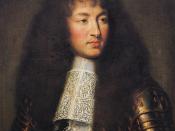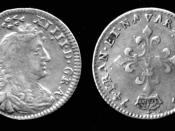Louis XIV of France was the third ruler from the Bourbon dynasty. He ruled for seventy-two years. It was the longest reign in European history. He centralized government and expanded the borders of France.
When Louis XIV became an absolute monarch, he first prevented officials from abusing power and tried to stop corruption. Other goals were centralizing government, establishing borders, and replenishing the treasury. He had an unofficial cabinet to help him make decisions that was led by the Chief Minister of Finance Jean-Baptiste Colbert. Colbert helped to replenish the treasury by developing trade and industry. Colbert also built a new navy. Louis established borders by building forts and through military campaigns. Louis XIV centralized the government by sending intendents, or governors, to each region to represent the king and watch the nobles.
Within France, a Catholic nation, many Huguenots, or Protestants, lived there. Louis XIV, a Catholic, was against the Huguenots, and he repealed the Edict of Nantes.
The Edict of Nantes allowed Protestant civil rights and their right to hold religious services legally. The Estates General, a representative assembly, was held in many provinces. Louis XIV and the Estates General had never any problems, and he never called them to a meeting during his rule, but in Brittany, there was an open revolt. Early in Louis' rule, parlements registered royal edicts, but they could obstruct royal policies by not informing the public of certain laws. Most parlements lost power by the late 1600's and then Louis issued an ordinance so that all parlements had to register his orders.
France had several treaties with Spain and Netherlands, but didn't have any allies. The last years of Louis' rule was nearly all warfare. After King Phillip IV of Spain died, Louis XIV fought the War of Devolution to make sure...


